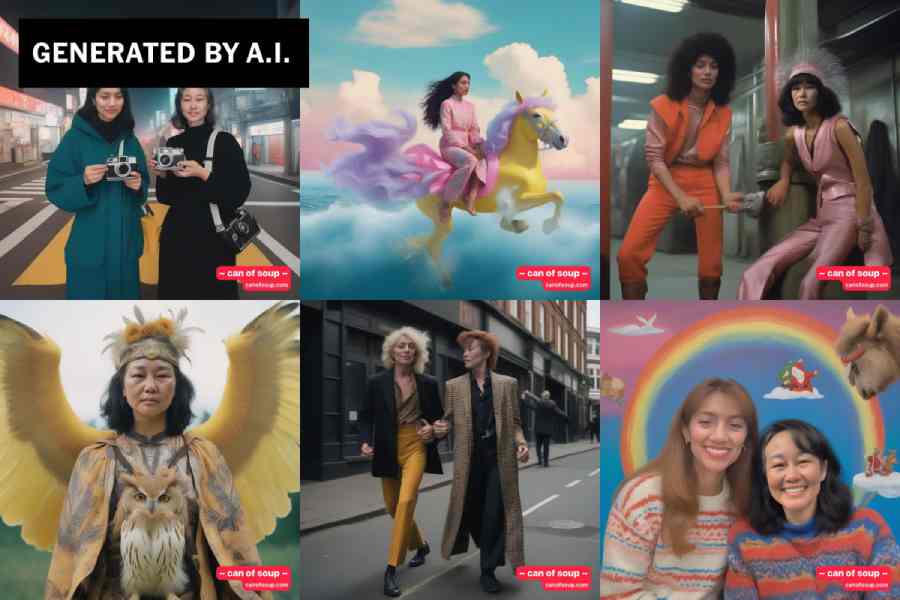Myuri Thiruna, a freelance photographer in Toronto, Canada, used to post frequently on Instagram and discuss photography with other users. But she said she had stopped two years ago, feeling “drained” by the demands of social media and the pursuit of followers and trends.
In July, Thiruna discovered Can of Soup, a new invitation-only social network where people make fantastical images of themselves with AI and share them. Enthralled, she created AI images that showed her sitting on a unicorn floating in an ocean, wearing a jacket made of Froot Loops.
“I met so many people on this app that I didn’t know before,” she said. “It’s this meaningful connection with people and being also inspired by what they’re doing.”
After Facebook, Instagram and other apps became more corporate over the years, AI imagery presents a way for them to bring back the whimsy and fun so users can rediscover what was once the point of the platforms: to share and interact with one another.
Large social platforms and new apps alike are incorporating AI image features. Snapchat announced Dreams, an AI imaging feature that lets users in Britain, Australia and New Zealand create outlandish selfies. TikTok last year rolled out several in-app filters that use AI to transform selfies into the style of a comic or a dreamlike character. BeFake, launched recently, is experimenting with AI selfies and images.
A few days ago, Facebook, Instagram, WhatsApp and Messenger jumped in as well. Meta said the services would now offer AI tools for instantly generating photorealistic stickers that can be shared. It added that it would introduce similar tools for editing and restyling existing images. These tools could put cowboy boots on two babies in a family photo, for instance.
“You can generate imagery inside of your chats,” said Ahmad Al-Dahle, Meta’s vice-president of generative AI. While most need 10 to 20 seconds to create an image, Meta’s new tool needs only five.
The growing number of AI imagery tools in various apps underlines how “using AI interactively is where social media will go,” said Sam Saliba, who was Instagram’s global brand marketing lead and is now a marketing and branding consultant in Silicon Valley.
The trend takes AI images further than the apps that allowed people to produce AI-generated images without conversing or easily sharing them in an online community. Those apps included Lensa AI — which let people create AI selfies in styles like “cosmic”, “fairy princess” and “anime” — as well as Remini, Snow and Wombo.
Ben-Zion Benkhin of Wombo said many didn’t stick with AI apps that were merely a “creation tool” and that gave users no ability to chat with one another about what they had produced. Adding social networking, he said, “does connect you to the other people.”
That understanding has helped drive new apps like BeFake, which has melded AI image features with socialising and sharing. BeFake prompts users at a different time every day to take a picture and then has AI transform the image.
BeFake connects people through their creativity, said founder Kristen Garcia Dumont. “What that means to each person is unique and intriguing, and you get to explore that with whoever you want in the app,” she said.
Hayley Fligel, 17, a high school student in Burlingame, California, US, said she began using BeFake after a friend invited her to join. It’s different from Snapchat, TikTok and Instagram, which are stressful because “if you want to take pictures or videos of yourself, you have to get ready, you have to get dressed, and you have to be doing something or have a nice background around you,” she said.
She said she could use AI on BeFake to make herself look like Taylor Swift or appear that she was playing volleyball, which shows “a more personal snippet of who you are”. While she seldom interacts with others on Instagram, she said, she comments on her friends’ posts on BeFake and browses a “Discovery” feed for inspiration from other posts.
Gabriel Birnbaum, who created Can of Soup with Eric Meier in May, said the point was to encourage creation and have fun. “It’s an app where you spend time with your friends,” he said.
NYTNS










